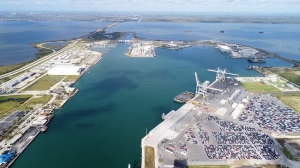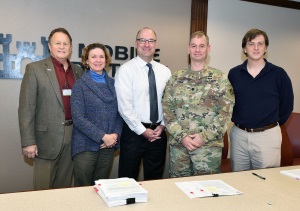Dredging: Canaveral, Gulfport
![]() Print this Article | Send to Colleague
Print this Article | Send to Colleague
Port Canaveral Completes Basin and Container Berth Deepening Project
Port Canaveral has completed the deepening of the West Turning Basin, which now allows deeper draft access to the container cargo facility operated by GT USA at North Cargo Berth 5 and 6.
The six-month project deepened the West Turning Basin to the authorized depth of 43 feet plus 2 feet additional over-dredge, complimenting the existing authorized main channel depth of 44 feet/13.4 meters. The channel to the West Turning Basin is clear from overhead obstructions such as bridges and wires, has no air draft restrictions and now has approximately 2,000 feet/610 metes of quay at 43 feet.
"The West Turning Basin deepening was necessary for Port Canaveral to allow larger cargo vessels safe access into our port," said Captain John Murray, the port authority’s CEO. "This project opens the port to bigger, modern industrial ships, vital to Central Florida’s economic success. We will experience a continued growth of cargo into the region, making Port Canaveral more competitive and increased economic opportunities."
More than 826,000 cubic yards/631,500 cubic meters of dredged material was removed by dredging contractor subject to conditions specified by of environmental permits issued by the U.S. Environmental Protection Agency (EPA), U.S. Army Corps of Engineers and Florida Department of Environmental Protection (FDEP).
With the deepening project complete, Port Canaveral is bidding to purchase a mobile harbor crane with an 18/19 container reach. The crane is expected to be fully operational by the end of 2018.
Seventy-five percent of the $7.5 million project cost was covered by a Strategic Intermodal System grant from the Florida Department of Transportation.

West Turning Basin at Port Canaveral
Photo/Port Canaveral
Gulfport Receives Record of Decision from Army Corps of Engineers for Expansion Project
The U.S. Army Corps of Engineers on November 28 released its Record of Decision (ROD) for a major expansion project at the Port of Gulfport.
The project includes a 282-acre dredge-and-fill program for further expansion of the west pier, north harbor, east pier, and the construction of a 4,000-linear foot breakwater system.
The ROD details the Corps of Engineers’ decision on all issues discussed in the Final Environmental Impact Statement (EIS), including the environmental impacts associated with the expansion project.
The environmental process involved several federal and state agencies including the U.S. Environmental Protection Agency, National Marine Fishers Service, National Oceanic Atmospheric Administration, Mississippi Development Authority, Mississippi Department of Environmental Quality and the Mississippi Department of Marine Resources.
The Corps found that "applicant’s proposed Project is the least environmentally damaging practical alternative that meets the overall project purpose and need" and concluded that "issuance of a permit for this project ...is consistent with national policy, statutes and administrative directives, and is not contrary to the public interest."
"As we near completion of our Restoration Project, the port is limited on how we can acquire waterfront land, making this a good time to receive the approved EIS permit," said Port Authority CEO Jonathan Daniels. "As our business portfolio continues to grow, it is necessary to evaluate future expansion options at the deepwater terminal that will allow for even greater throughput potential."

Meeting at U.S. Army Corps of Engineers office, Mobile (AL), November 28, for release of the Corps’
Record of Decision for the Port of Gulfport Expansion Project. From left: Bobby Knesal, Port of Gulfport Commission president; Elizabeth Calvit, Port of Gulfport environmental lead; Jonathan Daniels, Port of Gulfport CEO and director; Lt. Col. Andrew Yoder, deputy division commander; and Philip Hegji, project manager.
Photo/Port of Gulfport

